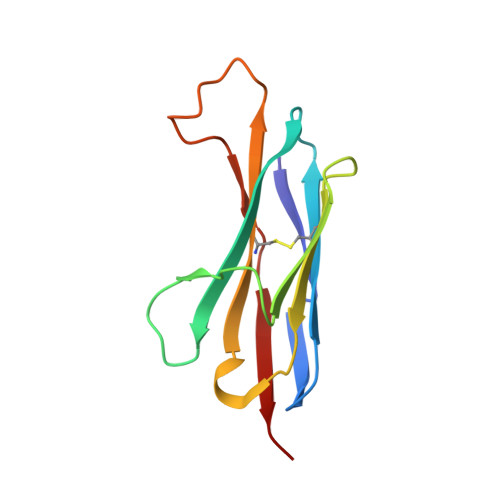Shark IgNAR antibody mimotopes target a murine immunoglobulin through extended CDR3 loop structures
Simmons, D.P., Streltsov, V.A., Dolezal, O., Hudson, P.J., Coley, A.M., Foley, M., Proll, D.F., Nuttall, S.D.(2007) Proteins 71: 119-130
- PubMed: 17932913
- DOI: https://doi.org/10.1002/prot.21663
- Primary Citation of Related Structures:
2YWY, 2YWZ - PubMed Abstract:
Mimotopes mimic the three-dimensional topology of an antigen epitope, and are frequently recognized by antibodies with affinities comparable to those obtained for the original antibody-antigen interaction. Peptides and anti-idiotypic antibodies are two classes of protein mimotopes that mimic the topology (but not necessarily the sequence) of the parental antigen. In this study, we combine these two classes by selecting mimotopes based on single domain IgNAR antibodies, which display exceptionally long CDR3 loop regions (analogous to a constrained peptide library) presented in the context of an immunoglobulin framework with adjacent and supporting CDR1 loops. By screening an in vitro phage-display library of IgNAR variable domains (V(NAR)s) against the target antigen monoclonal antibody MAb5G8, we obtained four potential mimotopes. MAb5G8 targets a linear tripeptide epitope (AYP) in the flexible signal sequence of the Plasmodium falciparum Apical Membrane Antigen-1 (AMA1), and this or similar motifs were detected in the CDR loops of all four V(NAR)s. The V(NAR)s, 1-A-2, -7, -11, and -14, were demonstrated to bind specifically to this paratope by competition studies with an artificial peptide and all showed enhanced affinities (3-46 nM) compared to the parental antigen (175 nM). Crystallographic studies of recombinant proteins 1-A-7 and 1-A-11 showed that the SYP motifs on these V(NAR)s presented at the tip of the exposed CDR3 loops, ideally positioned within bulge-like structures to make contact with the MAb5G8 antibody. These loops, in particular in 1-A-11, were further stabilized by inter- and intra- loop disulphide bridges, hydrogen bonds, electrostatic interactions, and aromatic residue packing. We rationalize the higher affinity of the V(NAR)s compared to the parental antigen by suggesting that adjacent CDR1 and framework residues contribute to binding affinity, through interactions with other CDR regions on the antibody, though of course definitive support of this hypothesis will rely on co-crystallographic studies. Alternatively, the selection of mimotopes from a large (<4 x 10(8)) constrained library may have allowed selection of variants with even more favorable epitope topologies than present in the original antigenic structure, illustrating the power of in vivo selection of mimotopes from phage-displayed molecular libraries.
Organizational Affiliation:
CSIRO Division of Molecular and Health Technologies, Parkville, Victoria 3052, Australia.














